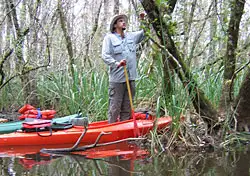
At first glance, Everglades City doesn’t appear to have much going for it. It’s a modest little town populated mostly by marinas, motels, and touristy airboat operators with names like Jungle Erv’s, Captain Doug’s, and Speedy Johnson’s. There are a few drab gator parks and a small national park outpost. But in real estate terms, Everglades City has three things in its favor: location, location, location.
Situated on the northwest corner of Florida’s Everglades National Park, where the salt water of the Gulf of Mexico mixes with the fresh water inland, Everglades City is an ideal base from which to explore America’s only subtropical wilderness preserve. More than just a “giant swamp,” the Everglades is home to a variety of egrets, blue herons, and wood storks, not to mention whole forests of mangrove and cypress trees and vast stretches of sawgrass marshes. It’s also the only place in the world where alligators and crocodiles live side by side.
David and Sandee Harraden’s Ivey House Bed & Breakfast in Everglades City is the base of operations for North American Canoe Tours, Inc. (NACT), which specializes in ecologically sensible Everglades exploration. They do it for those on a reasonable travel budget, too: Their most popular guided canoe and kayak trips run less than $100 per person.
In stark contrast to the glut of touristy (and environmentally questionable) airboat operators in the area, NACT excursions are led by a naturalist guide and are limited to two to 12 kayakers or canoers per group. I chose a kayak daytrip into the Everglades backcountry ($95 for Ivey House guests, $119 for non-guests), which stretches inland, away from the 10,000 islands region on the Gulf Coast.
My guide, a ruddy, broad-shouldered South African named Vaughn who once led safaris in the Kalahari Desert, took my group of seven kayakers into the marshy backcountry waters where claustrophobic tunnels of mangrove trees and giant cypress trees are everywhere.
The swamp is literally teeming with wildlife, too—the kind that’s impossible to observe on one of the pre-packaged boat excursions from which most visitors experience the park. What you see and hear is nature at its most primordial. No cars, no motor boats, no vacation homes or carelessly tossed trash. Just the soft splash of paddle touching water, the frequent calls of birds, the occasional splash of jumping fish, and the wind whistling through the leafy ceiling overhead.
The gaters we saw were usually no more than a pair of cold eyes staring out from the still green water, sometimes as close as a few feet to either side of my kayak. Vaughn called them the Kings of the Everglades, and instructed us to follow NACT’s golden rule: “Look, but don’t touch.” We’d paddle slowly past and leave the kings to rule from their swampy throne.
Planning your trip
The Everglades are at their most accessible in the winter months. The Ivey House operates excursions from November 1 through April 30, when the weather is milder and the bugs aren’t as bad (always a consideration in a swampy environment that is home to more than 40 species of mosquitoes). On my trip in late January, the temperature was a comfortable 68 degrees and I barely noticed the mosquitoes.
NACT offers guided trips as well as kayak and canoe rentals for independent exploration. Their guided single-day trips range from $80 to $125 (slightly more for non-Ivey House guests), and include a packed lunch and all transportation and equipment. If you have more time (and considerably more money), overnight camping trips of up to seven nights are available as well.
Everglades City is two hours west of Miami, three hours north of Flamingo, and just over three hours south of Tampa. Many low-cost airlines, including Southwest, Song, and JetBlue, fly to Florida, which gives budget-conscious travelers a number of options for getting there on the cheap. Renting a car to get around is also a necessity.
Other options
There are many ways to see the Everglades. Boat tours depart frequently from the national park outposts. There are also hiking and bike paths, and the famous airboats are everywhere around the park (but not inside it). Most airboat outings last 30 to 60 minutes and top out around $30 per person. If you opt for an airboat tour, be sure to sort through the assortment of brochures available at the tourist outposts. Most airboat operators offer family discounts for those who shop around. Speedy Johnson’s, for example, takes off $5.00 per couple if you bring their brochure with you when you book.
Airboats are undeniably an exhilarating way to see the Everglades, capable of reaching speeds exceeding 25 miles a hour, and turning on a dime in the narrow maze of tunnels and islands. They’re also exceedingly loud (earmuffs are given to all passengers) and leave considerable waves in their wake. The environmental impact of these boats is a matter of some debate, but what isn’t debatable is that if you wish to experience the Everglades’ fragile ecosystem as it truly is, you won’t find it on an airboat. Think of it as more a thrill ride than a nature jaunt, and decide for yourself if it’s something that interests you.
You Might Also Like:
We hand-pick everything we recommend and select items through testing and reviews. Some products are sent to us free of charge with no incentive to offer a favorable review. We offer our unbiased opinions and do not accept compensation to review products. All items are in stock and prices are accurate at the time of publication. If you buy something through our links, we may earn a commission.
Related
Top Fares From
Today's Top Travel Deals
Brought to you by ShermansTravel
Greece: 9-Night Vacation, Incl. Meteora &...
Exoticca
 vacation
$2099+
vacation
$2099+
New Year Sale: Luxe, 9-Nt Alaska...
Oceania Cruises
 cruise
$3599+
cruise
$3599+
Ohio: Daily Car Rentals from Cincinnati
85OFF.com
 Car Rental
$19+
Car Rental
$19+



